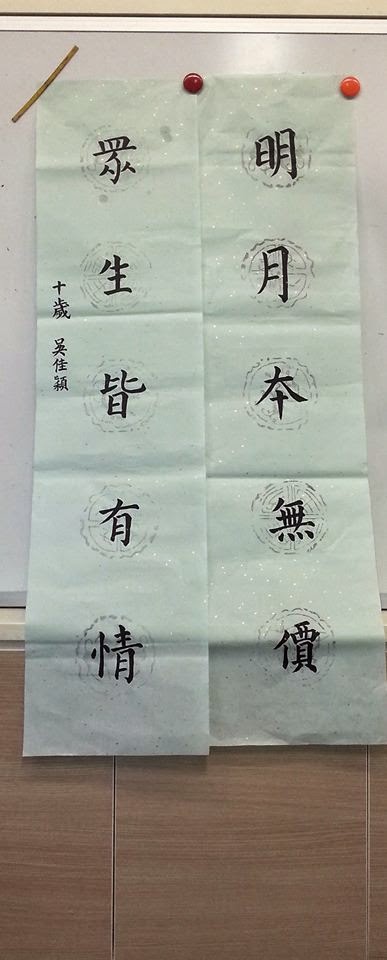 This
paper is intended to provide the calligraphic beginners with some basic
understanding of Chinese Calligraphy. According to Encyclopaedia Britannica,
the word “calligraphy” derives from the Greek words “for good or beautiful”, –
an artwork or a major art, equivalent to painting.
This
paper is intended to provide the calligraphic beginners with some basic
understanding of Chinese Calligraphy. According to Encyclopaedia Britannica,
the word “calligraphy” derives from the Greek words “for good or beautiful”, –
an artwork or a major art, equivalent to painting.
Calligraphy
is simply an art in writing the Chinese language. It has developed through the millennia into
an enduring and sophisticated tradition which becomes a distinctive feature of
Chinese civilization. Special instruments have been invented by the Chinese calligraphic
works. They include the special brush, ink, paper and ink stone. They are
commonly known as the four treasures of the studio.
 |
文房四宝: 笔、墨、纸、砚
Four treasures of the studio: brush, ink, paper and ink stone.
|
Chinese
language is unique because it is not alphabetical. The ancient Chinese words,
like the Egyptian hieroglyphs, were pictorial images or simplified images. Each
character is composed of a number of differently shaped lines. Unlike Western
languages which are sound symbols for pronunciation; Chinese language covers
three elements of thoughts, sound and physical form.
As
an advanced form of fine art, Chinese calligraphy has two keynotes namely, a
stimulation in every stroke and a dynamic equilibrium in the structure. The
work expresses the character, deposition and propensity, as well as the good
and bad fortune of the calligrapher.
Chinese calligraphy has been a main feature in
Chinese civilization. Calligraphy or (Shu fa 书法)
was one of the Six Arts (Liu yi 六艺)
in ancient China. Confucius (551 – 479 BC) strongly advocated that every
scholar should study the Six Arts.
 In
the Zhou Dynasty (1122 – 255 BC) the education system was based fundamentally on
the teaching of calligraphy. (周以书为教)
Since the Tang dynasty (618 – 906AD) the skill in calligraphy was one of the
prerequisites for the civil service (汉以书取士). Calligraphy became a
compulsory subject for all scholars who wanted to sit for the imperial
examinations which were held once in three years.
In
the Zhou Dynasty (1122 – 255 BC) the education system was based fundamentally on
the teaching of calligraphy. (周以书为教)
Since the Tang dynasty (618 – 906AD) the skill in calligraphy was one of the
prerequisites for the civil service (汉以书取士). Calligraphy became a
compulsory subject for all scholars who wanted to sit for the imperial
examinations which were held once in three years.
The
imperial examinations were abolished in 1905, but calligraphy remains a main feature
in China Civilization. The interest in calligraphy has attracted the attention
of Chinese scholars all over the world.
In Singapore, calligraphy is not a compulsory
subject in schools. It is part of an enrichment programme introduced by the
Ministry of Education.
Personally, I feel that the schools, particularly
the Special Assistance Plan Schools (SAP schools) should encourage their
students to learn calligraphy.
The supporting factors include:
a) Encouragement for the students’ interests in
studying the Chinese language.
b) Enhancement of morale education or development of
traditional good values.
Calligraphy is easy to learn but difficult to
master. The cost in providing such training is negligible. What is needed is
essentially to engage a competent teacher for the courses which are normally
held at week-end.
Note: The writer is the Honorary Auditor of Nyee Ann
Kongsi, adviser to Nyee Ann Cultural Centre, Shicheng Calligraphy &
Seal-carving Society, and Singapore South-East Asia Art Association. He is also
a Director of Singapore Teochew Federation and governor, Singapore Teochew Foundation.












































